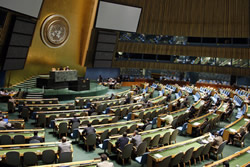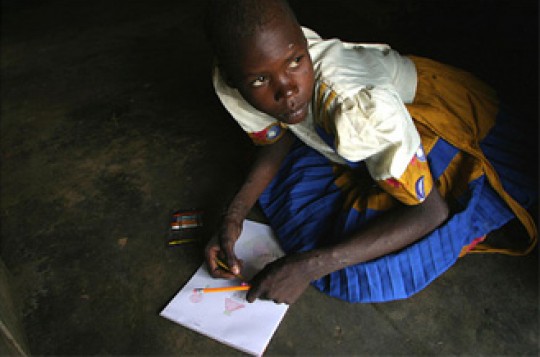International Day for the Abolition of Slavery – 2 December
International Day for the Abolition of Slavery – 2 December
“To eradicate contemporary forms of slavery, we need new strategies and measures that can unite all actors. While Governments bear the primary responsibility, the private sector has an integral role to play. Earlier this year, the Human Rights Council endorsed the Guiding Principles on Business and Human Rights, outlining how states and businesses should implement the UN “Protect, Respect and Remedy” Framework. I welcome the widespread support it has received from the business sector.”
Message for the International Day
for the Abolition of Slavery
A girl recovers from her year-long captivity by the Lord’s Resistance Army, Uganda. Photo: UNICEF
The International Day for the Abolition of Slavery, 2 December, marks the date of the adoption, by the General Assembly, of the United Nations Convention for the Suppression of the Traffic in Persons and of the Exploitation of the Prostitution of Others (resolution 317(IV)of 2 December 1949).
The focus of this day is on eradicating contemporary forms of slavery, such as trafficking in persons, sexual exploitation, the worst forms of child labour, forced marriage, and the forced recruitment of children for use in armed conflict.
In 2007 the UN marked the 200th Anniversary of the Abolition of the Transatlantic Slave Trade on 25 March. In 2008 the International Day of Remembrance of the Victims of Slavery and the Transatlantic Slave Trade became an annual observance.
Background
Slavery has evolved and manifested itself in different ways throughout history. Today some traditional forms of slavery still persist in their earlier forms, while others have been transformed into new ones.
The UN human rights bodies have documented the persistence of old forms of slavery that are embedded in traditional beliefs and customs. These forms of slavery are the result of long-standing discrimination against the most vulnerable groups in societies, such as those regarded as being of low caste, tribal minorities and indigenous peoples.
Forced labour
Alongside traditional forms of forced labour, such as bonded labour and debt bondage there now exist more contemporary forms of forced labour, such as migrant workers, who have been trafficked for economic exploitation of every kind in the world economy: work in domestic servitude, the construction industry, the food and garment industry, the agricultural sector and in forced prostitution.
Child labour
According to data provided by UNICEF, globally, one child out of every six works. The majority of the child labour that occurs today is for economic exploitation. That goes against the Convention on the Rights of the Child, which recognizes “the right of the child to be protected from economic exploitation and from performing any work that is likely to be hazardous or to interfere with the child’s education, or to be harmful to the child’s health or physical, mental, spiritual, moral or social development.”
Trafficking
According to the Protocol to Prevent, Suppress and Punish Trafficking in Persons Especially Women and Children, trafficking in persons means the recruitment, transportation, transfer, harbouring or receipt of persons, by means of the threat or use of force or other forms of coercion for the purpose of exploitation. Exploitation includes prostitution of others or other forms of sexual exploitation, forced labour or services, slavery or practices similar to slavery, servitude or the removal of organs. The consent of the person trafficked for exploitation is irrelevant and If the trafficked person is a child, it is a crime even without the use of force.
Message of the Secretary-General for 2011
Despite the considerable efforts of Governments, civil society and the international community, we still live in a world blighted by slavery and slavery-like practices. Millions of human beings are subjected to an existence that is almost unfathomable in its degradation and inhumanity.
Debt bondage, serfdom and forced labour; trafficking in persons and trafficking for the purpose of organ removal; sexual exploitation, the worst forms of child labour, forced marriage, the sale of wives, widow inheritance, and the forced recruitment of children for use in armed conflict – these are among the manifestations of slavery today. All are crimes and egregious violations of human rights.
To eradicate contemporary forms of slavery, we need new strategies and measures that can unite all actors. While Governments bear the primary responsibility, the private sector has an integral role to play.
Earlier this year, the Human Rights Council endorsed the Guiding Principles on Business and Human Rights, outlining how states and businesses should implement the UN “Protect, Respect and Remedy” Framework. I welcome the widespread support it has received from the business sector. The corporate responsibility to respect includes ensuring that their activities do not cause or contribute to contemporary forms of slavery in the workplace, and taking steps to stop it from happening in supply chains and elsewhere.
UN.Gift — the Global Initiative to Fight Human Trafficking that brings together the ILO, OHCHR, UNICEF, UNODC, IOM and the OSCE — as well as the UN Global Compact corporate sustainability initiative, have also been active in encouraging the private sector to do its part in raising awareness about modern slavery and taking proactive steps to eliminate it.
This year, the UN Voluntary Fund on Contemporary Forms of Slavery marks twenty years of helping victims to regain their independence, lives and dignity. The Fund has supported projects that provide vocational training, education, legal advice, medical and psychological assistance. It has also targeted the social factors that can foster slavery. The Fund needs a minimum of $1.5 million to fulfil its mandate, but less than a third of this amount has been secured to date.
On this International Day, I appeal to all governments, business enterprises, NGOs and other partners to demonstrate their commitment to fighting slavery by making a financial contribution to the Fund, and by working closely together to end this scourge.
Ban Ki-moon
Documents
General Assembly Resolutions
Economic and Social Council Resolutions
Secretary General’s Reports
International Instruments
- Convention on the Rights of the Child: Optional Protocol on the Sale of Children, Child Prostitution and Child Pornography (2000) [A/RES/54/263]
- United Nations Convention against Transnational Organized Crime: Protocol to Prevent, Suppress and Punish Trafficking in Persons, Especially Women and Children (2000) [A/RES/55/25]
- Recommendation on Consent to Marriage, Minimum Age for Marriage and Registration of Marriages (1965) [A/RES/2018 (XX)]
- Convention on Consent to Marriage, Minimum Age for Marriage and Registration of Marriages (1962) [A/RES/1763 (XVII)]
- Supplementary Convention on the Abolition of Slavery, the Slave Trade, and Institutions and Practices Similar to Slavery (1956)
- Protocol amending the Slavery Convention signed at Geneva on 25 September 1926 (1953)
- Convention for the Suppression of the Traffic in Persons and of the Exploitation of the Prostitution of Others (1949) [A/RES/317 (IV)]
- Universal Declaration of Human Rights (1948) [A/RES/217 (III)]
- Slavery Convention (1926)
- Additional Declarations and Conventions on Human Rights
International Labour Organization Conventions
- Forced Labour Convention (1930) [No. 29]
- Abolition of Forced Labour Convention (1957) [No. 105]
- Minimum Age Convention (1973) [No. 138]
- Worst Forms of Child Labour Convention (1999) [No. 182]

Resources
UN.GIFT
Children and Armed Conflict
UNiTE
OHCHR
- Special Rapporteur on Contemporary forms of slavery
- Voluntary Trust Fund on Contemporary Forms of Slavery
- Special Rapporteur on trafficking in persons, especially in women and children
- Special Rapporteur on the sale of children, child prostitution and child pornography
ILO
UNICEF
UNODC
UNFPA
UNESCO
WomenWatch
UN Works
###
> United Nations (UN).
 The United Nations was established on 24 October 1945 by 51 countries committed to preserving peace through international cooperation and collective security. Today, nearly every nation in the world belongs to the UN: membership totals 192 countries.
The United Nations was established on 24 October 1945 by 51 countries committed to preserving peace through international cooperation and collective security. Today, nearly every nation in the world belongs to the UN: membership totals 192 countries.
When States become Members of the United Nations, they agree to accept the obligations of the UN Charter, an international treaty that sets out basic principles of international relations. According to the Charter, the UN has four purposes:
- to maintain international peace and security;
- to develop friendly relations among nations;
- to cooperate in solving international problems and in promoting respect for human rights;
- and to be a centre for harmonizing the actions of nations.
###
* The above story is adapted from materials provided by United Nations (UN)
** More information at United Nations (UN)





















